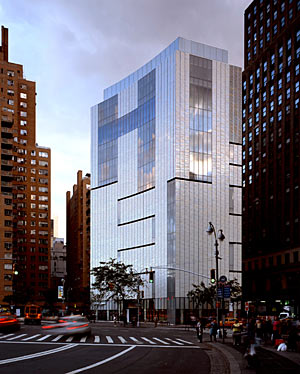After three years of construction, and an even longer period of controversy, the Museum of Arts and Design is throwing open the doors of its new Manhattan home. Designed by Brad Cloepfil, AIA, the 10-story, 54,000-square-foot facility at Two Columbus Circle is the result of a massive renovation of a 1964 building by Edward Durell Stone, FAIA.

Photo © Hélène Binet
After three years of construction, the Museum of Arts and Design is opening its new Manhattan home. Designed by Brad Cloepfil, the 10-story museum at Two Columbus Circle is the result of a massive renovation of a 1964 building by architect Edward Durell Stone.
Originally home to the Huntington Hartford Gallery of Modern Art, a short-lived museum, and later, city offices, the structure is perhaps better known as “the lollipop building” for its signature ground-level columns, which feature slender white marble stems topped by darker disks. Though never fully embraced by New York’s design community, the building nonetheless became a flashpoint for a bitter preservation battle once plans to alter it were announced in 2002, after the museum bought it for $17 million.
Among the well-known personalities who urged the city’s Landmarks Preservation Commission to hold public hearings on the building, so they could argue for protection of its facade, were writers Tom Wolfe and Witold Rybczynski, architect Robert A.M. Stern, artist Chuck Close, and Yale scholar Vincent Scully. And they were backed by a raft of state, federal and international groups, including the Preservation League of New York State, the World Monuments Fund, and the National Trust for Historic Preservation, which in 2004 listed Two Columbus Circle among the country’s most-endangered buildings. “There was a broad acknowledgement that this was something that needed to be saved,” says Kate Wood, executive director of Landmark West, a local preservation group that between 2001 and 2005 organized the opposition. “Now the damage is done.”
Others, though, dismissed the architectural significance of the building, which had porthole-like openings dotting the length of its corners. Chief among the detractors was Ada Louise Huxtable, former architecture critic of The New York Times, who in the 1960s famously called it “the die-cut Venetian palazzo on lollipops” and continued to pan the building until construction of the Cloepfil project began in 2005, after the landmarks commission ruled out hearings.
Though the $90-million project didn’t change the site’s concave footprint, Cloepfil, a principal of Allied Works Architecture, based in Portland, Oregon, has significantly altered the building’s exterior. Its white marble surface has given way to a terra cotta skin, made up of 22,000 tiles, whose iridescent glaze took two years to develop, Cloepfil says. He’s also added jigsaw-cut-like bands of two-foot-wide windows, allowing natural light into rooms originally sheathed in dark walnut. Some of the new windows run clerestory-style along the ceilings; others slash vertically to the floors, where they meet same-width glass strips embedded in oak boards that crisscross the galleries.
Adding natural light without sacrificing too much exhibit wall space was a major challenge, Cloepfil says, but nothing like the larger one of tackling such a highly charged commission. “It would be hard to imagine a project more controversial, with more scrutiny, than this,” says Cloepfil, whose portfolio includes the Contemporary Art Museum St. Louis (2003) and the Seattle Art Museum expansion (2006).
For its part, the Museum of Arts and Design, which is tripling the capacity of its previous address at 40 West 53rd Street, welcomes a bigger home for its collection of handmade crafts, such as glass bowls, stoneware, bronze chairs and ceramic heads. Meanwhile, “Second Lives,” a show on floors four and five, offers everyday objects repurposed as art, like a wall of butterflies cut from vinyl long-play records.
Holly Hotchner, the museum’s executive director, wasn’t available to comment for this story. But in a press release, she spoke of the building’s perks, as “a dramatic new space in which we can fully realize our mission to explore the craftsmanship and creative processes of contemporary artists and designers.”
The museum opens to the public on Saturday, September 27. A ninth-floor restaurant run by Ark Restaurants, the company that owns the Bryant Park Grill in Midtown, will open this spring.




Post a comment to this article
Report Abusive Comment